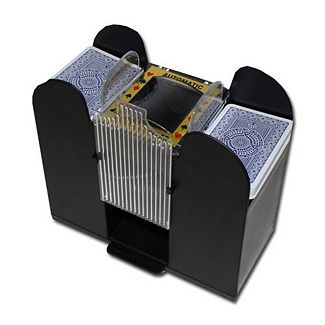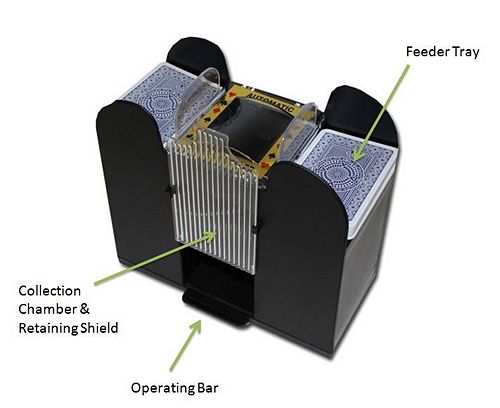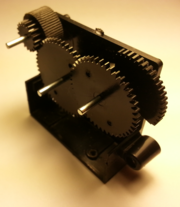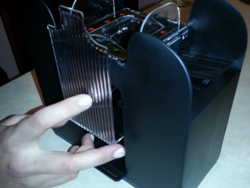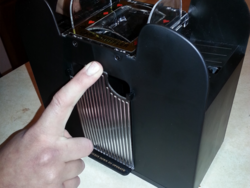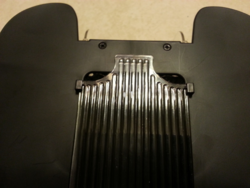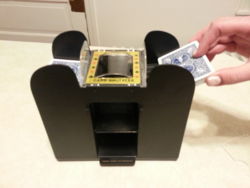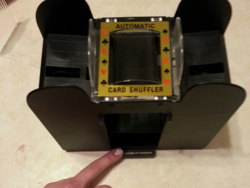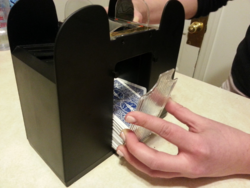Card shuffler 3
From DDL Wiki
(→Product Function and Evaluation) |
(→Product Function and Evaluation) |
||
| Line 68: | Line 68: | ||
''Step-by-Step Product Use'' | ''Step-by-Step Product Use'' | ||
| - | |||
1. Retrieve shuffler from storage location and place on playing table. | 1. Retrieve shuffler from storage location and place on playing table. | ||
Revision as of 00:38, 31 January 2014
Contents |
Executive Summary
Primary Stakeholders and Product Needs
Distributor Needs
Distributor needs are concerned with the ease and safety of transport.
- Packed with smallest possible box to save space
- Packed with rectangular box to stack efficiently
- Packed robustly enough to withstand bumps and slight drops
- Batteries either not included or shipped according to U.S. Department of Transportation
Retailer
Retailers have the same needs as distributors for stocking purposes, plus some needs unique to the seller of the product.
- Packaging is colorful and intriguing to costumers
Consumer
The product is primarily aimed at amateur card players who require a system for their home. Taking this into account, consumer needs are mainly related to portability, performance, maintenance and safety.
- Small
- Light
- Small table footprint
- Battery powered
- Shuffle quickly and thoroughly
- Minimal jamming
- Quiet
- Easy to load/unload
- Shuffle anywhere from 1 to 6 decks
- Work with brand new and used cards
- Long batter life
- Easily replaced batteries
- Easily fixed jams
- Robust
- Minimal Assembly
- Affordable
- Aesthetic product
- Safe to use and store
Product Function and Evaluation
Mechanical Function
Both sides of the card shuffler are mirrored and work independently. Their only connection is through the electrical circuit which closes once the bar is depressed. The following is a description of one independent side of the card shuffler.
The main mechanical function of the card shuffler comes from the motor/gearbox components. When the circuit is completed, the motor pinion turns the gearing system shown in figure 1. The pinion gear turns the first gear on the far right. This gear then translates its motion in two ways: 1) It directly rotates the agitator gear attached behind it on the same shaft 2) It translates its motion through the second gear to turn the third gear. The third gear is attached to a rubber wheel that grips a card from the feeder tray and slides it into the collection chamber. The agitation gear is a quarter gear that slightly protrudes above the feeder tray. This facilitates a steady flow of individual cards by vibrating the stack so that no cards stick together.
Upon entering the collection chamber, the cards encounter a routing surface (Part #adsf in Figure #adfasdf) which angles the cards downwards towards the base of the collection chamber. The base of the collection chamber sits on springs which compress as more cards are shuffled. This prevents the cards from flipping over on their way down the collection chamber by keeping the top of the stack close to the entrance of the chamber. Figure #adfs shows the platform of the collection chamber in its fully extended position; as cards stack in the collection chamber, the springs compress and the platform lowers.
Preliminary User Study
Step-by-Step Product Use
1. Retrieve shuffler from storage location and place on playing table.
2. Place clear retaining shield into appropriate position through:
- a. rest base on top of spring-loaded platform
- b. depress fully
- c. release ensuring retaining shield slots into guide clips
3. Load half of cards into each feeder tray.
4.Depress bar labeled “push down to operate” until no cards remain in feeder trays.
5.Lower and remove retaining shield.
6.Enjoy your freshly shuffled cards.
User Commentary
Overall, we believe that the product worked well for its reasonable price and relatively compact design. Through thorough testing of our 6-deck model, we were able to recognize key pros and cons that have been outlined below.
The product saved time shuffling the cards especially when using multiple decks. The product exhibited a small table footprint which definitely was an advantage of its design as it allowed ample room on the playing table for the users and the game being played. Moreover, the simple design also meant that the product was easy to use. A bar was the only part that needed to be pressed to make the shuffler function and this simplicity also meant that the design looked sleek and non-intrusive on the table.
The product did, however, have room for improvement in many categories. Firstly, when operated, the shuffler was surprisingly loud which distracted players and interfered with conversations between users. When a single deck needed to be shuffled, the product was not very time efficient and was not significantly faster than shuffling by hand. This was primarily down to the retaining shield which needed to be first inserted then removed from the product. We also experienced multiple instances of cards flipping or getting stuck in the collection chamber when being shuffled. This was very time consuming since the whole deck needed to be reshuffled. In one instance, when trying to repair a jam that occurred, one card was damaged in the process which is another area of improvement. Finally, the product required uncommon “C” batteries which was not expected of a device that is meant to be used at home.
List of Parts
Design For Manufacturing and Assembly [DFMA]
Design For Manufacturing [DFM]
This card shuffler was clearly designed for cheap and effective mass production. The following highlight both clear applications of DFM and areas where DFM was lacking.
Successful DFM implementations:
- Mirrored design
- Identical design to other models
- Slide-in battery contacts
- Drafted internal screw mounting posts + drafted card chamber
- Motor drives feeder + agitator (only 1 motor per side)
- Almost exclusively injection molded plastic
- Gears, motors, fasteners can be purchased cheaply pre-assembled
- Loose tolerances
- Stickers and colored plastic remove need for paint
Potential Improvements:
- Riser for gear box unnecessary
- Outer casing 5 components, possible to make with fewer
- Undrafted support posts resulted in irregular finish.
- Injection molds have complex features
Due to the low price point the manufacturers of the card shuffler are targeting, DFM is extremely important for high volume/low cost production. One of the simplest ways the manufacturers streamlined their process is by utilizing identical components on each half of the shuffler, halving the unique parts required. Furthermore this shuffler uses identical internal electrical and mechanical components and basic structural components from other models designed for fewer decks of cards, allowing for established high-volume production to be used across all product lines. More complex components (like gears and motors) were likely purchased inexpensively in large quantities from other vendors saving time for the shuffler manufacturer. The vast majority of the shuffler is made from injection molded plastic components with some attention to draft angles for mold releasing, increasing production rates. Additionally, loose tolerances are required throughout the product making it even easier to produce. By using colored plastic and decorative/instructional stickers, the manufacturer avoids having to paint the device.
No device is perfect and the shuffler manufacturer had room to improve in a few areas. The motor/gearbox assemblies stand on risers to accommodate the additional height of the 6 deck shuffler, adding additional components. This design choice was made to preserve the use of existing motor/gearbox assemblies across all shufflers but complicates the 6 deck model. The outer casing could be made with fewer individual components instead of the current five separate components. The battery cavities in the base of the shuffler have many complex features and cutouts, increasing manufacturing difficulty. Of particular note were four cylindrical support posts in the base with straight sides. When pulled from the mold, the outer layers of the posts wrinkled and bunched irregularly. These components are internal and this defect does not affect the shuffler's appearance or operation.
Design for Assembly [DFA]
Successful DFA Implementations:
- 2 motor/gearbox system avoids complex transmission system
- Motors wired in series (less wires than parallel)
- Ultrasonic welding between parts
- Complex motor/gearbox combo can be independently assembled/tested
- All mechanical components operate without outer shell in place
- Screw posts have lip that function as guide pins for the enclosure and base
- Shuffler build bottom-up
- Loose tolerances allow for quick assembly
Potential Improvements:
- Screws could be replaced by snap-fit fixtures
- Gearbox stands add additional assembly steps
- Sticker requires careful placement to preserve aesthetics
- Spring attachment points used hand-melted rivets
Failure Mode and Effect Analysis [FMEA]
Design for Environment [DFE]
Team Members [TM]
Role:Rodrigo Bergamasco
Role:Allen Kim
Role:Alexander Kozhemiakov
Role:Angela Nawrocki
Role:Pranay Sharm
